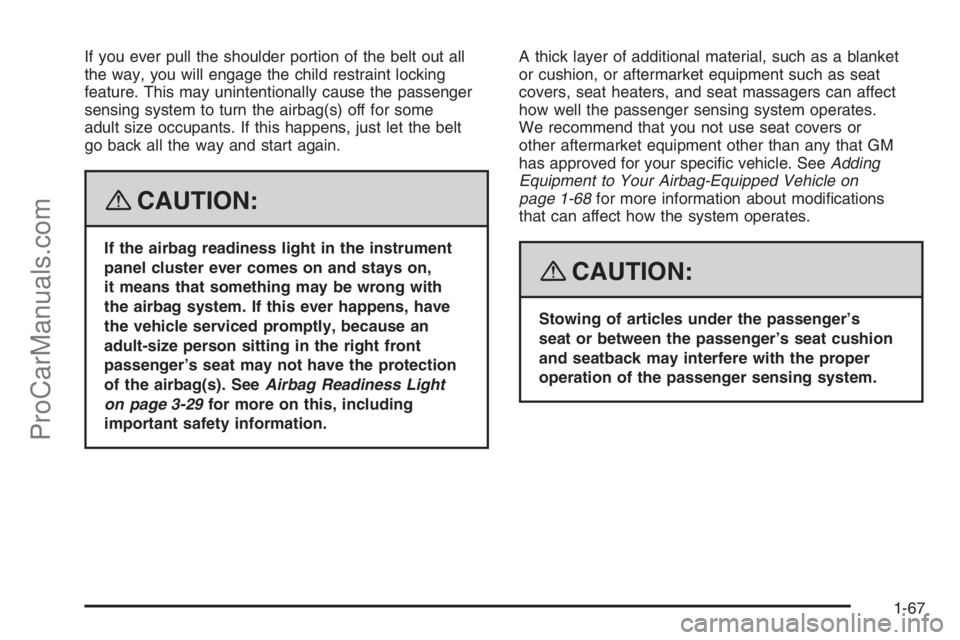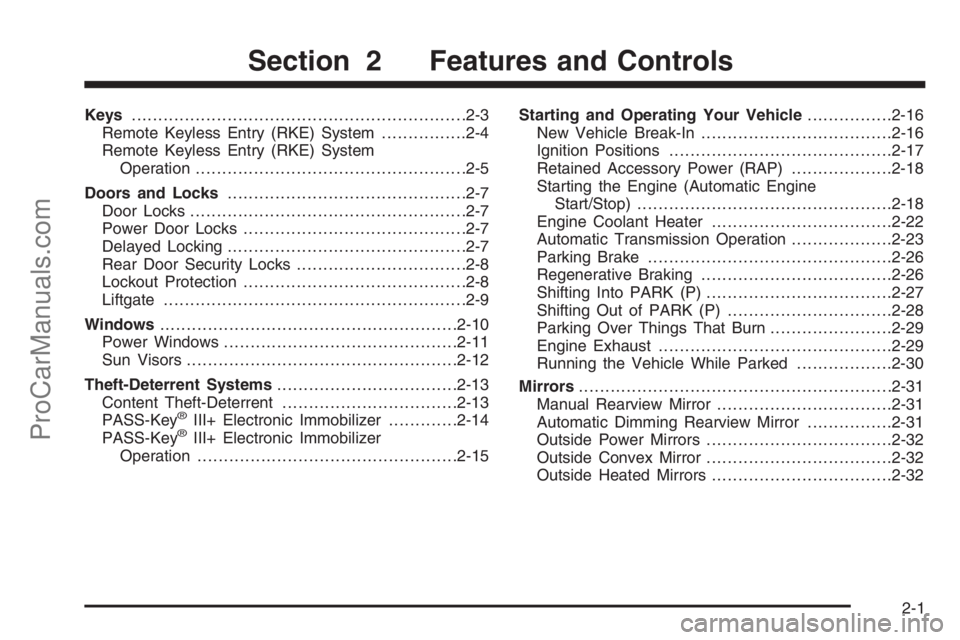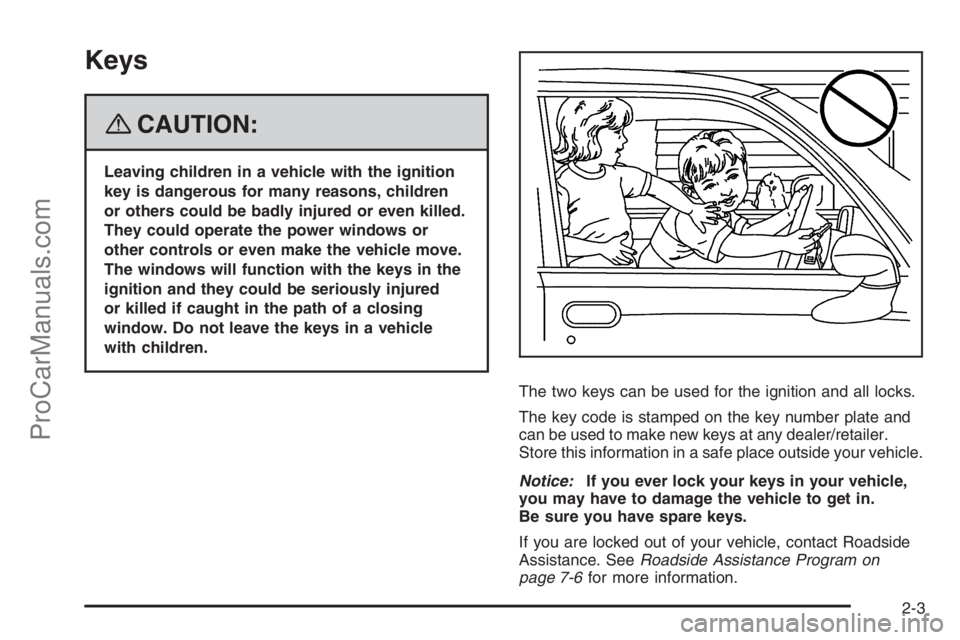SATURN VUE HYBRID 2008 Manual PDF
Manufacturer: SATURN, Model Year: 2008, Model line: VUE HYBRID, Model: SATURN VUE HYBRID 2008Pages: 384, PDF Size: 2.56 MB
Page 71 of 384

If you ever pull the shoulder portion of the belt out all
the way, you will engage the child restraint locking
feature. This may unintentionally cause the passenger
sensing system to turn the airbag(s) off for some
adult size occupants. If this happens, just let the belt
go back all the way and start again.
{CAUTION:
If the airbag readiness light in the instrument
panel cluster ever comes on and stays on,
it means that something may be wrong with
the airbag system. If this ever happens, have
the vehicle serviced promptly, because an
adult-size person sitting in the right front
passenger’s seat may not have the protection
of the airbag(s). SeeAirbag Readiness Light
on page 3-29for more on this, including
important safety information.A thick layer of additional material, such as a blanket
or cushion, or aftermarket equipment such as seat
covers, seat heaters, and seat massagers can affect
how well the passenger sensing system operates.
We recommend that you not use seat covers or
other aftermarket equipment other than any that GM
has approved for your speci�c vehicle. SeeAdding
Equipment to Your Airbag-Equipped Vehicle on
page 1-68for more information about modi�cations
that can affect how the system operates.
{CAUTION:
Stowing of articles under the passenger’s
seat or between the passenger’s seat cushion
and seatback may interfere with the proper
operation of the passenger sensing system.
1-67
ProCarManuals.com
Page 72 of 384

Servicing Your Airbag-Equipped
Vehicle
Airbags affect how your vehicle should be serviced.
There are parts of the airbag system in several places
around your vehicle. Your dealer/retailer and the
service manual have information about servicing your
vehicle and the airbag system. To purchase a service
manual, seeService Publications Ordering Information
on page 7-14.
{CAUTION:
For up to 10 seconds after the ignition is
turned off and the battery is disconnected,
an airbag can still in�ate during improper
service. You can be injured if you are close
to an airbag when it in�ates. Avoid yellow
connectors. They are probably part of the
airbag system. Be sure to follow proper
service procedures, and make sure the person
performing work for you is quali�ed to do so.
Adding Equipment to Your
Airbag-Equipped Vehicle
Q:Is there anything I might add to or change
about the vehicle that could keep the airbags
from working properly?
A:Yes. If you add things that change your vehicle’s
frame, bumper system, height, front end or side
sheet metal, they may keep the airbag system from
working properly. Changing or moving any parts
of the front seats, safety belts, the airbag sensing
and diagnostic module, steering wheel, instrument
panel, roof-rail airbag modules, ceiling headliner
or pillar garnish trim, front sensors, side impact
sensors, rollover sensor module, or airbag wiring
can affect the operation of the airbag system.
1-68
ProCarManuals.com
Page 73 of 384

In addition, your vehicle has a passenger sensing
system for the right front passenger’s position,
which includes sensors that are part of the
passenger’s seat. The passenger sensing system
may not operate properly if the original seat
trim is replaced with non-GM covers, upholstery
or trim, or with GM covers, upholstery or trim
designed for a different vehicle. Any object,
such as an aftermarket seat heater or a comfort
enhancing pad or device, installed under or on
top of the seat fabric, could also interfere with
the operation of the passenger sensing system.
This could either prevent proper deployment of
the passenger airbag(s) or prevent the passenger
sensing system from properly turning off the
passenger airbag(s). SeePassenger Sensing
System on page 1-63.
If you have any questions about this, you should
contact Customer Assistance before you modify
your vehicle. The phone numbers and addresses
for Customer Assistance are in Step Two of
the Customer Satisfaction Procedure in this manual.
SeeCustomer Satisfaction Procedure on page 7-2.If your vehicle has rollover roof-rail airbags, see
Different Size Tires and Wheels on page 5-62
for additional important information.
Q:Because I have a disability, I have to get my
vehicle modi�ed. How can I �nd out whether
this will affect my airbag system?
A:If you have questions, call Customer Assistance.
The phone numbers and addresses for Customer
Assistance are in Step Two of the Customer
Satisfaction Procedure in this manual. See
Customer Satisfaction Procedure on page 7-2.
In addition, your dealer/retailer and the service manual
have information about the location of the airbag
sensors, sensing and diagnostic module and airbag
wiring.
1-69
ProCarManuals.com
Page 74 of 384

Restraint System Check
Checking the Restraint Systems
Safety Belts
Now and then, make sure the safety belt reminder
light and all your belts, buckles, latch plates,
retractors and anchorages are working properly.
Look for any other loose or damaged safety belt
system parts. If you see anything that might keep a
safety belt system from doing its job, have it repaired.
Torn or frayed safety belts may not protect you in
a crash. They can rip apart under impact forces.
If a belt is torn or frayed, get a new one right away.
Make sure the safety belt reminder light is working.
SeeSafety Belt Reminders on page 3-28for more
information.
Keep safety belts clean and dry. SeeCare of Safety
Belts on page 5-81.
Airbags
The airbag system does not need regularly scheduled
maintenance or replacement. Make sure the airbag
readiness light is working. SeeAirbag Readiness Light
on page 3-29for more information.
Notice:If an airbag covering is damaged, opened,
or broken, the airbag may not work properly.
Do not open or break the airbag coverings.
If there are any opened or broken airbag covers,
have the airbag covering and/or airbag module
replaced. For the location of the airbag modules,
seeWhat Makes an Airbag Inflate? on page 1-61.
See your dealer/retailer for service.
1-70
ProCarManuals.com
Page 75 of 384

Replacing Restraint System Parts
After a Crash
{CAUTION:
A crash can damage the restraint systems
in your vehicle. A damaged restraint system
may not properly protect the person using it,
resulting in serious injury or even death in
a crash. To help make sure your restraint
systems are working properly after a crash,
have them inspected and any necessary
replacements made as soon as possible.
If you have had a crash, do you need new belts or
LATCH system (if equipped) parts?
After a very minor crash, nothing may be necessary.
But the belt assemblies that were used during any
crash may have been stressed or damaged. See your
dealer/retailer to have your safety belt assemblies
inspected or replaced.If your vehicle has the LATCH system and it was
being used during a crash, you may need new LATCH
system parts.
New parts and repairs may be necessary even if the
belt or LATCH system (if equipped), was not being
used at the time of the crash.
If an airbag in�ates, you will need to replace airbag
system parts. See the part on the airbag system earlier
in this section.
Have your safety belt pretensioners checked if your
vehicle has been in a crash, if your airbag readiness
light stays on after you start your vehicle, or while you
are driving. SeeAirbag Readiness Light on page 3-29.
If you have been in a collision in which either side
of your vehicle has been hit, the vehicle’s sensing
system may alert the automatic battery disconnect to
open. The battery will disconnect. The electrical
power to the vehicle will be off and the vehicle will not
start. The airbag readiness light will come on. See
Airbag Readiness Light on page 3-29. To operate your
vehicle, the automatic battery disconnect must be
reconnected by a quali�ed service technician and
sensing system parts will need to be replaced.
Have your vehicle serviced right away.
1-71
ProCarManuals.com
Page 76 of 384

✍NOTES
1-72
ProCarManuals.com
Page 77 of 384

Keys...............................................................2-3
Remote Keyless Entry (RKE) System................2-4
Remote Keyless Entry (RKE) System
Operation...................................................2-5
Doors and Locks.............................................2-7
Door Locks....................................................2-7
Power Door Locks..........................................2-7
Delayed Locking.............................................2-7
Rear Door Security Locks................................2-8
Lockout Protection..........................................2-8
Liftgate.........................................................2-9
Windows........................................................2-10
Power Windows............................................2-11
Sun Visors...................................................2-12
Theft-Deterrent Systems..................................2-13
Content Theft-Deterrent.................................2-13
PASS-Key
®III+ Electronic Immobilizer.............2-14
PASS-Key®III+ Electronic Immobilizer
Operation.................................................2-15Starting and Operating Your Vehicle................2-16
New Vehicle Break-In....................................2-16
Ignition Positions..........................................2-17
Retained Accessory Power (RAP)...................2-18
Starting the Engine (Automatic Engine
Start/Stop)................................................2-18
Engine Coolant Heater..................................2-22
Automatic Transmission Operation...................2-23
Parking Brake..............................................2-26
Regenerative Braking....................................2-26
Shifting Into PARK (P)...................................2-27
Shifting Out of PARK (P)...............................2-28
Parking Over Things That Burn.......................2-29
Engine Exhaust............................................2-29
Running the Vehicle While Parked..................2-30
Mirrors...........................................................2-31
Manual Rearview Mirror.................................2-31
Automatic Dimming Rearview Mirror................2-31
Outside Power Mirrors...................................2-32
Outside Convex Mirror...................................2-32
Outside Heated Mirrors..................................2-32
Section 2 Features and Controls
2-1
ProCarManuals.com
Page 78 of 384

OnStar®System.............................................2-33
Universal Home Remote System......................2-36
Universal Home Remote System Operation
(With One Triangular LED)...........................2-37
Storage Areas................................................2-41
Glove Box...................................................2-41
Cupholders..................................................2-42
Instrument Panel Storage...............................2-42Sunglasses Storage Compartment...................2-42
Center Console Storage.................................2-42
Rear Seat Armrest........................................2-43
Convenience Net..........................................2-43
Cargo Cover................................................2-43
Cargo Tie Downs..........................................2-43
Cargo Management System...........................2-44
Sunroof.........................................................2-44
Section 2 Features and Controls
2-2
ProCarManuals.com
Page 79 of 384

Keys
{CAUTION:
Leaving children in a vehicle with the ignition
key is dangerous for many reasons, children
or others could be badly injured or even killed.
They could operate the power windows or
other controls or even make the vehicle move.
The windows will function with the keys in the
ignition and they could be seriously injured
or killed if caught in the path of a closing
window. Do not leave the keys in a vehicle
with children.
The two keys can be used for the ignition and all locks.
The key code is stamped on the key number plate and
can be used to make new keys at any dealer/retailer.
Store this information in a safe place outside your vehicle.
Notice:If you ever lock your keys in your vehicle,
you may have to damage the vehicle to get in.
Be sure you have spare keys.
If you are locked out of your vehicle, contact Roadside
Assistance. SeeRoadside Assistance Program on
page 7-6for more information.
2-3
ProCarManuals.com
Page 80 of 384

Remote Keyless Entry (RKE)
System
If this vehicle has the Remote Keyless Entry (RKE)
system, it operates on a radio frequency subject
to Federal Communications Commission (FCC)
Rules and with Industry Canada.
This device complies with Part 15 of the FCC Rules.
Operation is subject to the following two conditions:
1. This device may not cause interference.
2. This device must accept any interference received,
including interference that may cause undesired
operation of the device.
This device complies with RSS-210 of Industry Canada.
Operation is subject to the following two conditions:
1. This device may not cause interference.
2. This device must accept any interference received,
including interference that may cause undesired
operation of the device.Changes or modi�cations to this system by other than
an authorized service facility could void authorization to
use this equipment.
If there is a decrease in the RKE operating range,
try this:
Check the distance. The transmitter may be too
far from the vehicle. Stand closer during rainy
or snowy weather.
Check the location. Other vehicles or objects may
be blocking the signal. Take a few steps to the
left or right, hold the transmitter higher, and
try again.
Check the transmitter’s battery. See “Battery
Replacement” later in this section.
If the transmitter is still not working correctly,
see your dealer/retailer or a quali�ed technician
for service.
2-4
ProCarManuals.com